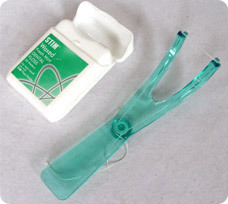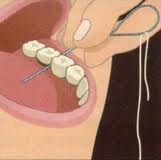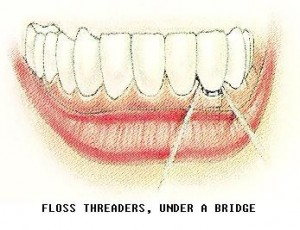Proper instruction and practice allows most motivated adults to master either the spool or loop method of flossing. In certain circumstances, the use of a floss holder, floss threader, variable-thickness floss, or pre-cut floss strands with a stiff end may be more effective.
Dental Floss Holder
The dental floss holder is a dental device that eliminates the need for placing fingers in the mouth. It is recommended for individuals with:
- A strong gag reflex
- Large hands
- Limited mouth opening
- Physical disabilities
- Poor manual dexterity and/or
- Low motivation for traditional flossing.
The floss holder may also be helpful when one person is assisting another with flossing. The proper use of the floss holder will require effective initial education and necessary reinforcement. The use of the floss holder may aid in developing a flossing habit and should be considered when individuals experience difficulty with manual dental flossing.
A variety of different floss-holder designs are available. Most commonly, they consist of a yoke-like device with a 3/4- to 1-inch space between the two prongs of the yoke. The floss is secured tightly between the two prongs and the handle is grasped to guide the floss during use. The width and length of the handle are important features to consider when a dental professional recommends the use of a floss holder to those with limited gripping abilities. Most floss holders require that floss be strung around various parts of the holder prior to each use. This assembly mechanism allows for re-threading of the floss whenever the working portion becomes soiled or begins to fray. Some devices have a floss reservoir in the handle. This improvement allows for ease of threading and advancing the floss while maintaining the proper tautness. Several brands of pre-threaded, one-time-use floss holders are available; they require minimal dexterity, a factor that may help improve compliance.
When using a dental floss holder, the floss is inserted in between the teeth, using the same technique employed for finger-manipulated tooth flossing. Once through the contact point, the floss and holder are pushed towards the back to clean the front surface of a tooth or pulled towards the front to clean the back surface of the tooth. This pulling or pushing motion creates conformity to the curved shape of the tooth, thus allowing the floss to slide downwards into the gumline. The floss is then activated in the same manner as with finger-manipulated flossing of teeth, by moving the floss in the direction of the long axis of the tooth.
Strict attention should be given to achieving the desired floss tension when assembling the floss holder. To ensure tautness, the prongs can be forced together while securing the floss. The most persistent problems with the yoke-like devices are the difficulties in loading and threading the floss, maintaining tension of the floss between the prongs and decreased ability to adapt the floss into a C-shape around the surface between the teeth. Any dental device recommended should allow for ease of threading, maintenance of proper tautness, and easy manipulation by the user.
Automated floss holders have been introduced but have not shown an advantage over manual teeth flossing. However, those with large diameter handles may be especially helpful for individuals with limited manual dexterity and inability to grip a smaller diameter.
Dental Floss Threader
A floss threader is a plastic loop into which a length of floss is inserted, similar to threading a needle. The threader is used to carry the floss in between the teeth in the following circumstances:
- Through embrasure areas (the space under the teeth contact points) that are too tight for floss insertion,
- Between the proximal surface of tooth and gums of abutment teeth of fixed prostheses (the tooth holding the prostheses),
- Under pontics (artificial teeth),
- Around orthodontic appliances, and
- Under teeth that are splinted together.
Care should be taken to prevent trauma by not forcing the stiff end of the floss threader into the gum tissues. When cleaning under a fixed partial denture, the floss threader is inserted from the front or facial surface and pulled completely through to the inner aspect of the mouth until the floss is against the abutment or pontic. The floss may then be disengaged from the threader. The floss is adapted to one abutment tooth surface in the area of the embrasure and moved in the direction of the long axis of the tooth to remove plaque from the proximal surface.
It is important to glide the floss through the space between the pontic and the gums in order to clean the underside of the pontic. After cleaning the underside of the pontic, it is necessary to slide the floss to the opposite proximal surface. Removal of the floss from between the abutment and pontic is accomplished by pulling it out from the front or facial aspect.



